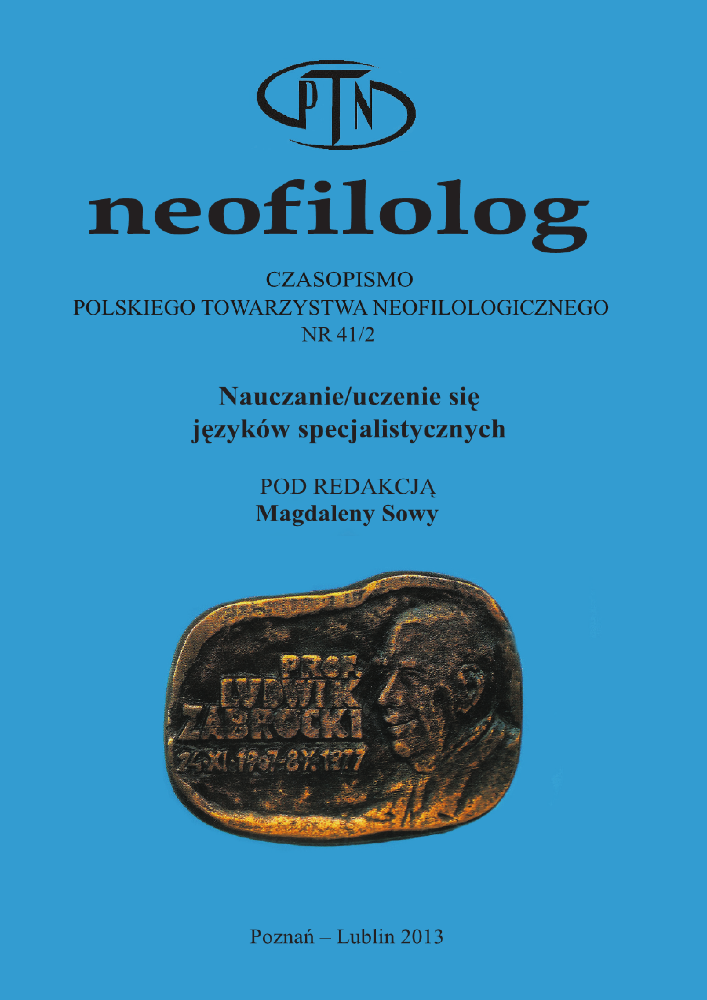Abstract
The present article is an attempt to present the situation in the area of Content and Language Integrated Learning at some technical universities in Poland. It starts with a brief outline of CLIL methodology as well as its status in the context of Polish tertiary education, and then moves on to a discussion of the results of the study conducted among Polish and international students attending English-medium courses in their specialist areas, such as, for instance, engineering. The courses involve learning of new, difficult concepts as well as specialized vocabulary. The study took place in three universities which have been offering content instruction in English for a number of years. Its aim was to investigate problems and difficulties that students come across during the course of their studies in a foreign language, as well as their expectations concerning such a mode of education.
Literaturhinweise
CLIL Matrix. 2004-2007. Achieving good practice in Content and Language Integrated Learning/bilingual education. http://www.ecml.at/mtp2/clilmatrix/EN/qMain.html CLIL Matrix [DW 30.10.2012]
Council of Europe. 2001. Common European Framework of Reference for Languages: learning, teaching, assessment. http://europass.cedefop.europa.eu/en/resources/european-language-levels-cefr [DW 30.10.2012].
Coyle, D., Hood, Ph., Marsh, D. 2010. Content and Language Integrated Learning. Cambridge: Cambridge University Press.
Crandall, J. 1998. “Collaborate and cooperate: teacher education for integrating language and content instruction”. English Teaching Forum 36/1: 2-9.
Eurydice Report. 2006. CLIL at school in Europe. Brussels: Eurydice. http://www.eurydice.org [DW 10.11.2013].
Gierlinger, E. 2012. “CLIL-ing me softly”. English Teaching Professional 82, September: 12-14.
Graddol, D. 2006. English Next. Plymouth: British Council
Key Competences for Lifelong Learning: European Reference Framework. 2007. 4. http://eur-lex.europa.eu [DW 30.10.2012].
Komorowska, H. (red.). 2011. Issues in Promoting Multilingualism. Teaching – Learning – Assessment. Warsaw: Foundation for the Development of the Education System.
Larsen-Freeman, D. 2000. Techniques and Principles in Language Teaching. (2nd edition). Oxford: Oxford University Press.
Łuczak, A. 2011. “ESP courses at universities. Preparing students for the challenges in the European markets” (w) Issues in Promoting Multilingualism. Teaching – Learning – Assessment (red. H. Komorowska). Warsaw: Foundation for the Development of the Education System. 59-77.
Mehisto, P., Marsh, D., Frigols, M. 2012. Uncovering CLIL. Content and Language Inte-grated Learning in Bilingual and Multilingual Education. London: Macmillan Publishers Limited.
Richards, J.C., Rodgers, T.S. 2001. Approaches and Methods in Language Teaching. Cambridge: Cambridge University Press.
Ruiz de Zarobe, Y., Sierra, J.M., Gallardo, F. 2011. Content and Foreign Language Integrated Learning: Contributions to Multilingualism in European Contexts, Bern: Peter Lang.
Stoller, F.L. 1997. “Project work: a means to promote language content”. English Teaching Forum 35/4: 2-9.
Lizenz
Copyright (c) 1970 Krystyna Droździał-Szelest, Liliana Szczuka-Dorna

Dieses Werk steht unter der Lizenz Creative Commons Namensnennung - Keine Bearbeitungen 4.0 International.
Autoren:
Die Autoren der zur Veröffentlichung in der Zeitschrift Neofilolog angenommenen Texte sind verpflichtet, den Vertrag über die Erteilung einer kostenlosen Lizenz für die Werke mit der Verpflichtung zur Erteilung einer Sublizenz CC auszufüllen, zu unterzeichnen und an die Adresse der Redaktion zurückzusenden.
Gemäß Vertrag erteilen die Autoren auf die in der Zeitschrift Neofilolog veröffentlichten Texte der Adam-Mickiewicz-Universität in Poznań eine nicht exklusive und kostenlose Lizenz und erlauben die Verwendung der Sublizenz Creative Commons Attribution-NoDerivatives 4.0 International (CC BY-ND 4.0).
Die Autoren behalten das Recht zur weiteren freien Verfügung über das Werk.
Benutzer:
Interessierte Onlinebenutzer dürfen die seit 2017 veröffentlichten Werke unter folgenden Bedingungen nutzen:
- Anerkennung der Urheberschaft - die Verpflichtung, zusammen mit dem verbreiteten Werk Informationen über die Urheberschaft, den Titel, die Quelle (Links zum Originalwerk, DOI) und die Lizenz selbst bereitzustellen;
- ohne Schaffung abgeleiteter Werke - das Werk muss in seiner ursprünglichen Form erhalten bleiben, ohne Zustimmung des Autors dürfen keine Studien, beispielsweise Übersetzungen, verbreitet werden.
Die Urheberrechte aller veröffentlichen Texte sind vorbehalten.
Sonstige:
Die Adam-Mickiewicz-Universität in Poznań behält das Recht auf die Zeitschrift als Gesamtheit (Layout, Grafik, Titel, Umschlagsprojekt, Logo usw.).
